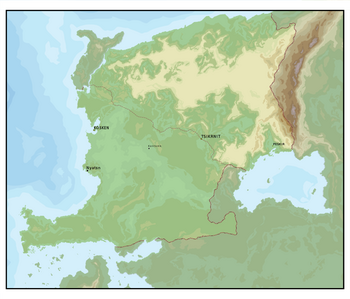Kankiesi-Tos Dual Republic
The Dual Kankiesi-Tos Republics Kankiesi-Tos Kzotr Hakemy | |
|---|---|
|
Flag | |
Motto: Itsenz Katn Nyoxamakn | |
| Capital | Tsikrnit, Kosken and Peskir |
| Largest city | Nyatsn |
| Official languages | Aletali |
| Ethnic groups (1096 SR) | Kankiesk, Tos |
| Demonym(s) | Tsenes, Kankiesian, Tos |
| Government | Dual Federal Republic |
• Chief Executive of Tosn | Kostrekn Miksmeon |
• Vice Chief Executive of Tosn | Tokan Mezkirtek |
• Chief Executive of Kankiesk | Tsanokel Kasnoxil |
• Vice Chief Executive of Kankiesk | Kzatlek Koztel |
| Legislature | The Tsekolez |
| The Kvary | |
| The Vekoz | |
| History | |
• The Arrival of Enesez Tribes in the highlands | 740 BKE (184 AD) |
• The Kantaket tribes break away and settle south in the lowlands | 717 BKE (207 AD) |
• Unification of Kankiesk and Tosn | 981 SR |
| Population | |
• 1095 SR estimate | 93,260,000 |
| GDP (PPP) | 1095 SR estimate |
• Total | WIP |
• Per capita | $25,050.74 |
| GDP (nominal) | 1096 SR estimate |
• Total | WIP |
• Per capita | WIP |
| HDI (1096 SR) | 0.883 very high |
| Currency | Tsenes Tsik |
| Driving side | left |
| Internet TLD | .KTDR |
Etsenes, officially the Kankiesi-Tos Dual Republic (Aletali: Kankiesi-Tos Kzotr Hakemy) is a republic located in Katzen, situated between the Srzek Mountains in the East, Kios Tiklet (Tiklet Sea) in the west, the Tos highlands and eventually the Kios Nyetenl (Nyetenl Sea) in the north, the Kiosikn Ostrek in the south-west, and the Kiosin Tsikot in the south east with a small bridge into the interior of the continent in the south-central region.
Etymology
The name Etsenes (Ets/E/ns) has very unclear origins, but it is generally just the name of the area in which the modern day Kankiesi-Tos Dual Republics inhabits, which is why the nation is generally just called Etsenes rather than its ridiculously long official name.
In Aletali, Etsenes (Ets/E/ns) is actually pronounced "Itsenez" (Ets/eh/neh/z), but much like in English, the demonyms for the two prominent sub-ethnic groups in the nation are the Kankiesians and the Tos, which are apart of the greater Tsenes (Aletali: Tsenz, Ts/eh/nz) ethnicity
History
Prehistory
It is highly unclear where they originated, but the arrival of the Enesez Tribes in 740 BKE (184 AD) marked the beginning of Tsenes Civilization. 23 years later, the tribal people split up, the Kantaket tribe migrating south into the lowlands, which provide fertile and easily colonizable land. The Enesez meanwhile stay in the highlands and mountains, which provide rich natural defenses but poor soil, natural resources, and trade ability, forcing them to continue in their traditional ways of life, with little technological advancement. as the Kantaket tribes settled the lowlands and southern areas, they lived in peace with the natives for a short time, but due to disputes about territorial encroachment, the more advanced Kantaket tribes expelled the natives from the lands, forcefully moving them onto Lekopatz Island across the Kiosikn Ostrek, which, having a very large desert covering most of the island, did not have the animal population to support that many people, so the native creatures on the island die off as the Tsenes natives hunt them for food. slowly, as the numbers dwindle, food becomes scarce and the expelled tribes begin fighting over food and resources to survive on. Chaos ensued on Lekopatz island which left little room for technological advancement.
As time went on, the Enesez tribe had more breakups which saw two more waves of settlers moved south to assimilate with the Kantaket, who mostly accepted them into their developing society. Meanwhile the Enesez tribe discovered the northern coast of Etsenes and slowly migrated from the highlands onto the coast, leaving the highlands depopulated and mostly barren. This also left many very well preserved abandon Enesez settlements for later discovery. The issue with this migration is that this added only another level of isolation to the Enesez settlements, who as a result didn't urbanize their land very much compared to the Kantaket tribes.
The Kantaket began trade with other cultures around the year 703 BKE and became a recognizable group of people as a result, as the isolated Enesez kept to themselves much more and slowly built their own society on principles of isolation and harmony within their civilization.
In 476 BKE, Kantaket adopted Hazkenakin as their common religion, becoming one of the largest Hazkenakin centers on the continent. At the time, Hazkenakin was a new religion, spread to the area by a more civilized society that Kantaket had been trading with.
Centuries of Disunity
Geography
Etsenes has a total area of 000000 sq mi (000000 sq kilometres), which is a fairly large size considering the size of the continent in all. Etsenes has actually be blessed with near perfect geography, the Srzek mountains in the North-East largely protect the nation from outside invaders, and the North, West, Central-East and South are all flanked by coast, The only geographic weakness the nation is presented with is the South-Eastern plain, which funnels foreigners right up into the nations heartland: the Lowlands. As a result, the nation has sought protection for its South-Eastern border for most of its history. Due to the fact that there are no natural barriers near the nations South-Eastern borders, the nation's primary focus for centuries is to A. Build a military that is powerful enough to keep out any invader, and B. Put as much distance between this weakness and foreign empires as possible. As a result, the Kankiesians have built some of the largest empires in the history of the continent.
 Topographical Map of Etsenes with Major Cities |
Climate
wip
Environment
wip
Politics and Government
wip
